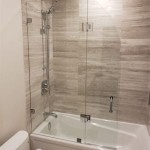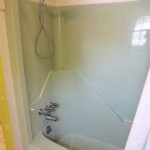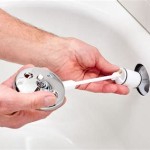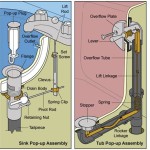What Are The Parts Of A Bathtub Faucet Called?
A bathtub faucet is a seemingly simple fixture, but its functionality relies on the interaction of several distinct components. Understanding the names and functions of these parts is essential for maintenance, repair, and even choosing a new faucet. This article will comprehensively break down the various parts of a typical bathtub faucet, providing a useful reference for homeowners, plumbers, and anyone interested in the inner workings of their plumbing.
Bathtub faucets come in various styles, including wall-mounted, deck-mounted, Roman tub fillers, and freestanding models. While the overall appearance and installation method can vary, the core components responsible for controlling water flow and temperature remain largely the same. This article will focus on the generic components found in most common bathtub faucet types.
The Spout
The spout is the most visually prominent part of the bathtub faucet, and its primary function is to deliver water into the tub. Spouts come in diverse shapes, sizes, and finishes to complement various bathroom designs. The material composition of the spout commonly includes brass, stainless steel, or other corrosion-resistant metals, often with a chrome, nickel, or bronze finish for aesthetic appeal and durability.
The design of the spout can significantly impact the water flow rate and pattern. Some spouts are designed for a laminar flow, creating a smooth, unbroken stream of water. Others might incorporate an aerator to mix air into the water stream, reducing splashing and potentially conserving water. The spout's reach, or the distance it extends from the faucet body, is another crucial factor to consider when choosing a bathtub faucet, as it must properly direct water into the tub without causing excessive splashing onto the surrounding surfaces.
Internally, the spout connects to the faucet body through a threaded connection or a compression fitting. In some cases, the spout is permanently attached to the faucet body. This connection must be watertight to prevent leaks. Over time, mineral buildup or corrosion can compromise this seal, leading to drips or more significant leaks around the base of the spout. Regular cleaning and inspection of this area can help prevent such issues.
Handles and Controls
The handles or controls are the mechanisms used to regulate the water flow and temperature. Bathtub faucets typically feature one or two handles. A single-handle faucet mixes hot and cold water using a cartridge or valve mechanism controlled by a single lever. Dual-handle faucets, on the other hand, separate the hot and cold water controls, allowing for independent adjustment of each.
The construction of the handles typically involves a metal core, often brass or zinc, with an exterior finish matching the spout. The handles are connected to the valve stems or cartridges via set screws or other fastening mechanisms. These mechanisms allow the user to rotate or lift the handle, thereby actuating the valve and controlling the water flow. The design of the handle influences the user's grip and ease of operation, so ergonomic considerations are important in their design.
Beneath the handle lies either a valve stem (in older compression faucets) or a cartridge (in newer, more common faucets). Valve stems use rubber washers that compress against the valve seat to shut off the water flow. These washers are prone to wear and tear, leading to drips and requiring periodic replacement. Cartridges, on the other hand, are self-contained units that control water flow and mixing. They are generally more durable and easier to replace than valve stems, though they can still fail over time due to mineral buildup or wear.
In some modern faucets, handles may be replaced by touch-sensitive or electronic controls. These advanced controls offer precise temperature adjustment and other features, such as programmable water fill levels. However, they also involve more complex electronics and may require professional installation and maintenance.
The Faucet Body
The faucet body is the central component that houses the various valves, cartridges, and connections. It serves as the foundation for the spout and handles, and it's responsible for directing water flow from the supply lines to the tub. The faucet body is typically made of brass or another durable metal to withstand the constant water pressure and temperature fluctuations.
The internal workings of the faucet body vary depending on the type of faucet. In a two-handle faucet, the body houses two separate valves, one for hot water and one for cold. These valves are connected to the handles via valve stems or cartridges. The faucet body also includes passages that allow the hot and cold water to mix before flowing out of the spout. The design and configuration of these passages influence the water pressure and flow rate.
The faucet body connects to the water supply lines, typically through threaded connections or compression fittings. These connections must be properly sealed to prevent leaks. The faucet body also includes mounting hardware that secures the faucet to the bathtub deck or wall. This hardware must be robust enough to support the weight of the faucet and withstand the forces exerted during normal use.
The faucet body's finish often matches the spout and handles, contributing to the overall aesthetic of the faucet. The finish must be durable enough to resist corrosion and tarnishing from water exposure and cleaning products. Regular cleaning and maintenance of the faucet body can help preserve its appearance and prevent premature failure.
Diverter Valve
Many bathtub faucets include a diverter valve, which allows the user to switch the water flow between the bathtub spout and the showerhead. The diverter valve is typically a lever or knob located on the faucet body or near the spout. When the diverter valve is in one position, water flows out of the spout. When the diverter valve is in the other position, water is directed to the showerhead.
The diverter valve operates using a sliding or rotating mechanism that redirects the water flow. This mechanism is typically made of brass or plastic and is designed to create a watertight seal in either position. Over time, mineral buildup or wear can compromise this seal, leading to leaks or failure of the diverter valve. Common diverter valve types include tee diverters, rotating diverters, and lift-rod diverters. Each type employs a different mechanism to redirect water flow.
The diverter valve is connected to the spout and showerhead through water pipes or hoses. These connections must be properly sealed to prevent leaks. The diverter valve's handle or knob is connected to the internal mechanism via a linkage that allows the user to easily switch between the spout and showerhead. The design of this linkage influences the ease of operation and the durability of the diverter valve.
Some modern faucets incorporate pressure-balanced diverter valves, which automatically adjust the water pressure to maintain a consistent temperature even when other water sources are being used in the house. This feature helps prevent sudden temperature changes that can be uncomfortable or even dangerous.
Aerator (Sometimes Included)
While not always present on bathtub faucets, an aerator may be included to mix air into the water stream. This serves several purposes: it reduces splashing, provides a softer water flow, and can conserve water by reducing the overall volume of water used. Aerators are typically small, mesh-like devices that screw into the end of the spout.
The aerator works by creating turbulence in the water flow, drawing air into the stream and mixing it with the water. This creates a frothy, aerated stream that feels softer to the touch and is less likely to splash. The size and design of the aerator influence the amount of air that is mixed into the water. An aerator can also act as a filter, trapping small particles of debris that may be present in the water supply.
Aerators are relatively easy to clean and replace. Over time, mineral buildup can clog the aerator, reducing its effectiveness. Regular cleaning by soaking it in vinegar or a descaling solution can remove these deposits and restore the aerator's performance. Replacement aerators are readily available at most hardware stores.
The inclusion of an aerator on a bathtub faucet can be a valuable feature, especially in areas where water conservation is a concern. It provides a more comfortable and efficient water flow while potentially saving water.
Escutcheon Plates and Trim
Escutcheon plates and trim are decorative elements that cover the faucet's mounting holes and connections, providing a finished and aesthetically pleasing appearance. These plates are typically made of metal or plastic and are available in various shapes, sizes, and finishes to match the faucet's style.
Escutcheon plates serve a functional purpose as well as an aesthetic one. They protect the surrounding surfaces from water damage and prevent debris from entering the mounting holes. They also help to conceal any imperfections in the installation, creating a clean and professional look. The trim pieces, such as handle bases and spout collars, further enhance the aesthetic appeal of the faucet.
The installation of escutcheon plates and trim is typically straightforward, involving screwing or snapping them into place. The fit should be snug and secure to prevent water from seeping behind the plates. Regular cleaning of the escutcheon plates and trim can help maintain their appearance and prevent corrosion.
The choice of escutcheon plates and trim can significantly impact the overall style of the bathroom. Carefully selecting these elements to complement the faucet and other bathroom fixtures can create a cohesive and visually appealing space.

Bathtub Parts Everyone Should Know About Part Names 2024

Bath Tub Spouts The Largest Selection Of On Web

Learn How To Remove And Install Various Tub Spouts

The Diffe Parts Of A Bathtub And How They Work Family Handyman

Learn How To Remove And Install Various Tub Spouts

Polished Chrome Courant 8p8 Ws2 Cospc 1 Handle Tub Shower Trim With Valve Pfister Faucets

Parts Of Shower Valve Name Diagram Linquip

Bathtub What S The Correct Name For This Type Of Bath And Shower Mixer Tap Home Improvement Stack Exchange
Shower Valve Types 101 How To Choose The Right Vevano

Word Request What Do You Call The Circular Thing Inside A Bathtub English Age Learners Stack Exchange








